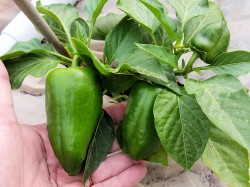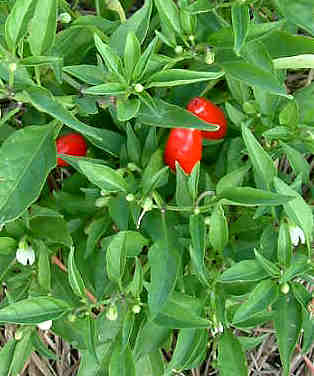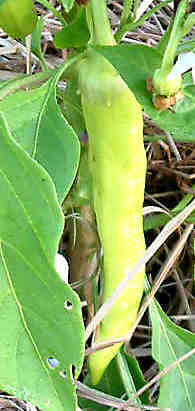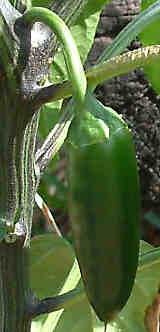How Long Do Pepper Plants Live?
How long do pepper plants live, anyway? Are they annuals, perennials or somewhere in between? Can you grow them indoors in the winter? Let’s take a look at the life of a pepper plant.
Note: In the years since I have written this post I have had more experiences with keeping pepper plants going — here’s my new post. (Read this one first, though, because it has additional information.)
Pepper Types (Species)
There are five main species of peppers:
- Capsicum annuum:Â Includes bell, sweet and many standard chile peppers like ancho, jalapeno, cayenne and more.
- Capsicum chinense:Â Includes datil, habanero and scotch bonnet peppers.
- Capsicum frutescens:Â Includes tabasco and thai peppers.
- Capsicum pubescens:Â Includes the South American rocoto peppers.
- Capsicum baccatum:Â Includes the aji peppers.
It’s important to know the species, as some are longer-lived than others. All pepper plants can be grown as annuals, but a few species can be perennial, provided they are in very warm, tropical climates.
There’s one pepper that seems to be cross-species, and that is the naga / bhut jolokia pepper. Originally called Capsicum frutescens, DNA testing has found some Capsicum chinense genes as well.
Capsicum Chinense as a Perennial
The Capsicum chinense peppers can live several years, providing they are in a warm climate. In theory, this means you can grow this species in a warm greenhouse as a perennial.
I’ve grown habaneros almost perennially here in South Florida, but I’m afraid that some of our cold snaps have done them in. This year I am trying habaneros and datils in containers, so that I can move them into the house (well, garage at any rate) when the temperatures fall below 45 degrees.
Capsicum Annuum
Your average pepper plant belonging to the species Capsicum annuum is generally grown as an annual. Although I have had some pretty long-lived jalapenos, they eventually get woody and die off.
I’ve never tried pruning a jalapeno, though, to see if I can revitalize it — that’s something I’ll have to try this year.
Although you really can’t grow them as a true perennial, Capsicum annuum can have an extended season. If you’re growing your pepper(s) in a container, you can try moving them indoors when the weather cools down. Just keep in mind that your pepper still needs plenty of sunlight; without sunlight, all the warmth in the world won’t extend your pepper’s life. That may mean a combination of south-facing window along with some supplemental light (grow lights).
Other Pepper Species
The same general rules apply to the other species; they need warmth and plenty of sunlight in order to keep growing. In their native tropical environments, the plants can live multiple years. But even in South Florida, they won’t necessarily live all year around — we do get chilly weather, and even as I write this, I’m expecting freezing temperatures tomorrow night.
So how long do pepper plants live? While they may not be perennial in the sense of living years on end, there are varieties that can grow several years — if you have the right climate.
Additional Reading
You might enjoy these related posts on peppers:
Growing Peppers From Seeds
Growing peppers from seeds isn’t as hard as you might think. The absolute hardest part is waiting for the seeds to germinate and poke their little heads above ground! (Well, that’s the hardest part for me, at any rate.) 🙂
So let’s take a look at what needs to happen in order to grow pepper plants from seeds.
Pick Your Pepper (Seeds)
First is to consider your climate, and where you plan to grow your pepper plants. Pepper plants love sunlight and warmth, so if you live in the Pacific Northwest, you’re a bit more challenged than someone who lives in the desert Southwest or Deep South.
If you live in a cooler climate, pick plants that produce peppers early in the season. It will take longer for the peppers to grow and mature, so an early season pepper is best. For sweet peppers, you may want to take a look at sweet banana peppers. These peppers are prolific and bear pretty early.
(Note: You don’t have to live in the Pacific Northwest to enjoy this pepper — you can grow it about anywhere.)
One further note about the Pacific Northwest climate is that hot chile peppers won’t get as hot where you live, compared to if you grew them in a warmer climate. Not sure why that happens, but be aware of it. Of course, deppending on the variety, they can be pretty hot anyway!
OK, say you live in a moderate climate; congratulations, you can grow about anything! If you have a fairly short Summer, you may want to stick with the earlier varieties (less than 60 days from transplant). But if you have a longer Summer, take your pick! One early-to-mid season bell which ripend to red that I like is called
Keystone bell pepper.
If you’re looking for a neat hot chili pepper to grow that produces and produces and then produces some more, think about Jalapeno M.
 Every time I have grown jalapenos, the plants have produced beyond expectations. I’ve always had plenty to eat, and plenty to share with family, friends and neighbors. In fact, one plant (planted in the garden in a large hole filled with compost) had so many peppers I almost considered selling them (the peppers, that is). It grew huge and was covered with jalapenos.
Every time I have grown jalapenos, the plants have produced beyond expectations. I’ve always had plenty to eat, and plenty to share with family, friends and neighbors. In fact, one plant (planted in the garden in a large hole filled with compost) had so many peppers I almost considered selling them (the peppers, that is). It grew huge and was covered with jalapenos.
OK, so most of my jalapeno plants didn’t go to quite those lengths, but each one has produced plenty of peppers for eating and sharing.
OK, you’re in the really southern climates with long summers and mild winters. You can grow just about anything as well, but hot chile peppers in particular love the climate. Of course, being a hot, hot, hot pepper lover, I choose habaneros and scotch bonnets. A nice one is Hot Paper Lantern habanero.
A word of warning for those of you who live in super-hot climates with strong summer sun — think about growing your peppers in dappled shade, or so they don’t get full sun from about noon to three. Living in South Florida, my summertime peppers do much better if they aren’t in full sun during the hottest part of the day.
And if anyone wants to check out more pepper seeds, take a look at this link for all kinds of pepper seeds.
To Be Continued…
This post has gotten longer than I had planned, so here’s part two of growing peppers from seeds, with the actual planting instructions.